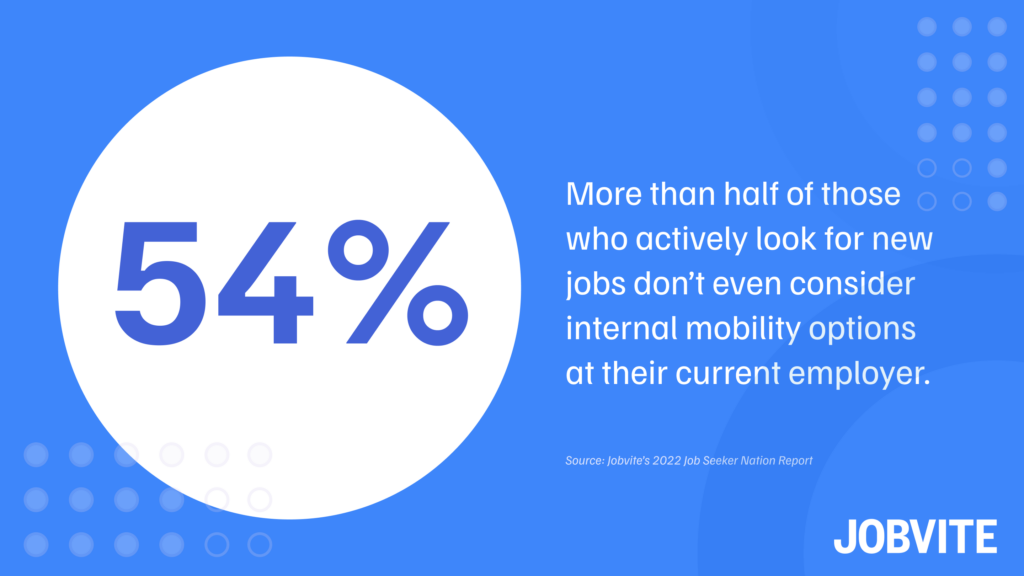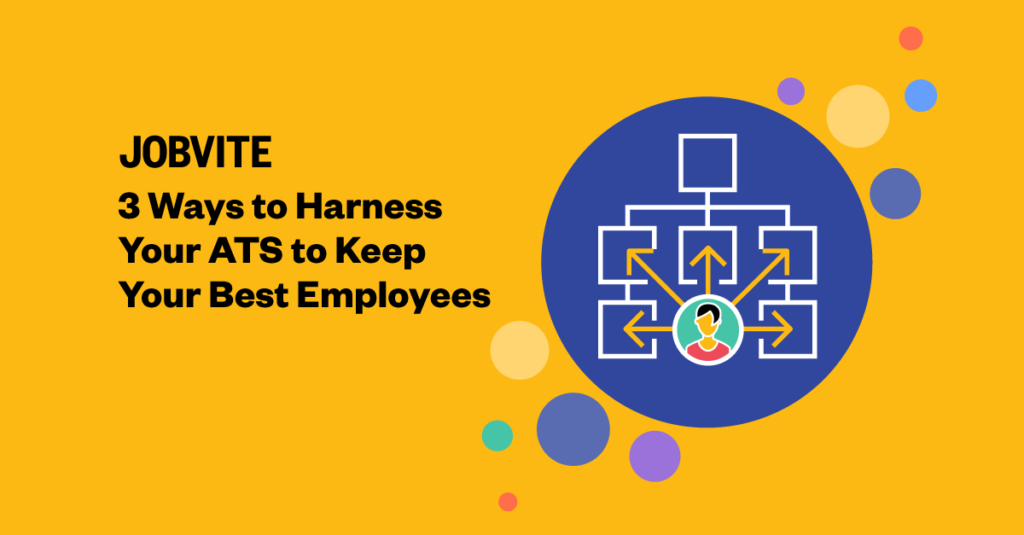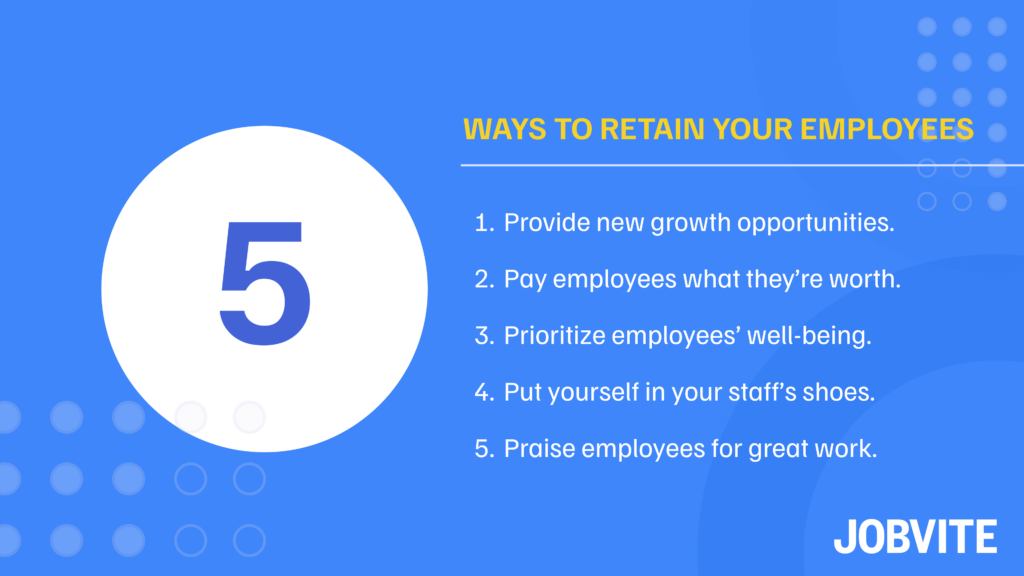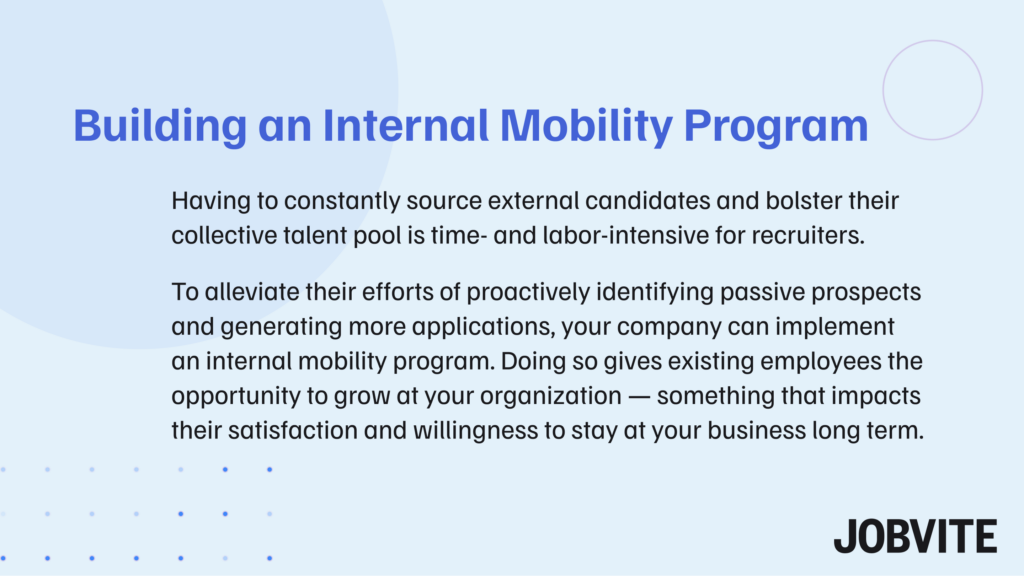In the competitive world of hiring, enterprises must prioritize the development and progress of their existing employees. Put another way? It’s just as vital to give appropriate attention to the talent already at your org (i.e., give them the chance to grow at your business) as it is to attract new, external talent to join your company.
Adopting an internal mobility strategy is one proven way to help employees advance professionally, retain top performers, and reward the talent you already spent time and resources to develop.
Internal mobility isn’t a new concept by any means.
However, the (many) benefits of internal mobility and its significance in the growth and success of your enterprise org bare repeating. (Especially in today’s volatile and uncertain labor market.)

What is internal mobility? A breakdown
Internal mobility refers to employees’ ability to move into new roles on or outside their current business unit. Internal mobility programs are typically owned by human resources, but require regular input from people managers to refer team members for active and upcoming roles.
These managers make said suggestions based on their direct reports’ recent performance long-term contributions. (That is, their team members’ recent and historical work that both helped achieve team and company goals and drive business growth, either directly or indirectly.)
That being said, it’s not always people managers (or departmental leaders) who recommend current employees for other positions.
Other times, recruiting team members identify existing employees based on assessment of these internal candidates, so to speak, via their ATS and/or HCM profiles.
And, sometimes, employees themselves proactively seek out info on new and future roles (usually by speaking with colleagues) across the business and request to be considered for those jobs.
Regardless of how internal talent (i.e., members of your workforce) become potential candidates, internal mobility is essential to helping employees realize their professional goals, gradually advance in the “right” direction in terms of their desired career path, and — ultimately — entices them to want to stay at the business long term, given they get the opportunity to grow in new roles.
At its core, there are three distinct types of internal mobility:
- Vertical movement: Promotion to a higher-level position, often with increased benefits
- Lateral movement: Transition to a different team or department with similar job functions
- Role enhancement: Taking on additional responsibilities in one’s current position
Implementing a solid internal mobility program helps employees grow their careers, engage in professional development, and acquire new skill sets that align with the enterprise’s goals.
Creating an internal mobility program is about more than filling open positions with existing team members. It’s about tapping into your current employees’ potential, allowing them to navigate career paths, hone skill sets, and contribute to the company more meaningfully.

The main benefits of internal mobility
More than half (54%) of professionals who noted they were actively looking for a job said they hadn’t looked at their current employer for a new role, per Jobvite’s 2022 Job Seeker Nation Report.
This data point — well — points to the most common issue facing orgs who build internal mobility programs. Those who own said programs don’t make them known to their existing employees.
Assuming you avoid this pitfall, your company will realize a variety of benefits from creating an internal mobility strategy. At the same time, you’ll offer your staff the chance to explore new roles and evolve their skill sets. (Something many job seekers want to see from employers today.)
Here are some key pros of internal mobility for both your business and employees.
New professional development opportunities
Thanks to internal mobility, employees have the opportunity to engage in professional development. By working on projects beyond their usual workflow, team members can develop new skills and enhance their existing expertise. This could even involve paying for employees to become certified.
Encouraging employees with diverse interests and career paths can help motivate your workforce. And a motivated workforce often leads to greater innovation, efficiency, and output.

Increased employee retention and satisfaction
The TA process is costly and time-consuming, making it all the more important for organizations to maximize the talents of their current employees. Encouraging internal mobility contributes to long-term growth by using the skills, knowledge, and expertise already present among team members.
Fostering an environment where every employee feel empowered to apply their unique skill sets creates a sense of loyalty, which leads to a higher retention rate among high performers.
(That is to say, the odds of employees moving to new companies decreases markedly.)
Per Deloitte’s 2021 Global Human Capital Trends, employees are more likely to stay with a company if they believe their career development needs are met. This is especially true for top talent in a given business who want to continuously learn, grow, and excel professionally.
Greater internal knowledge and skills transfer
A successful internal mobility strategy promotes the development of valuable skills across the org.
By challenging employees with new roles and projects, enterprises can improve the workforce’s overall expertise, agility, and adaptability. This translates into increased productivity and efficiency for the company, as well as bridging skills gaps that could arise within the organization.
When employees transition between roles, departments, or locations, they share their acquired knowledge with new colleagues. This internal knowledge transfer can help teams innovate, standardize best practices, and stay informed about industry developments.

Internal mobility best practices to know
The pros of employing an internal mobility program are clear. But, that begs the question:
How can you and other hiring stakeholders ensure your mobility efforts actually empower strong-fit internal candidates to take on new, meaningful work and ensure they contribute to business growth?
The short answer? By abiding by these three best practices.
1) Establish clear career pathways
Transparency is key when it comes to internal mobility. Provide your employees with well-defined career paths that illustrate opportunities for growth and progression within the organization.
Your C-suite and HR leadership must work with your department heads and team managers to define upward mobility paths for each (or at least most) roles across your business.
Once these are defined, employees can learn what tasks they need to take on, skills they need to gain (or improve), and goals they need to achieve to be considered for other roles by their manager.
2) Encourage skills development
Speaking of skills, equip your workforce with the necessary expertise to excel in new, prospective roles.
Your HR team needs to work with managers to carry out training and development programs that ultimately educate employees in various facets of business that could bolster their resumes, so to speak, and provide support to them throughout their career progression journey.
3) Utilize the right hiring technology
The best TA and HR tech stacks feature a powerful yet intuitive applicant tracking system that syncs directly and shares data with human resources systems.
By integrating your ATS and HRIS/HCM software, your recruiters can easily assess internal talent by viewing all historical details and data tied to their unified employee profile:
From when they were a job candidate, all the way to today.
This holistic view of all info tied to internal candidates allows talent specialists to reach out to staff members they think would be good fits for open or upcoming roles. What’s more, it reduces your talent acquisition team’s need to proactively source every time a new requisition opens up.
Learn how Jobvite can help your hiring team better identify and engage existing employees for internal mobility opportunities — and enhance your talent acquisition efforts at large.





